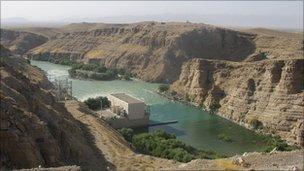What went wrong with Afghanistan Kajaki power project?
- Published
- comments
Watch Mark Urban's film about the Kajaki dam power project in full
Ever since Western forces plunged into Afghanistan a decade ago, they have realised the importance of winning hearts and minds, particularly in the restive south.
The idea that they could bring electricity to millions of people by upgrading the Kajaki dam in Helmand Province has proven to be a counter of counter-insurgency El Dorado - a quest into which lives and money have been poured, but so far without effect.
General David Petraeus, the commander of Nato forces in Afghanistan, told me during a recent interview that the Kajaki project had proven to be an object lesson in, "overpromising but under-delivery".
British officers once suggested the upgrade to the power facilities might be completed by the end of 2007, but today even the most optimistic assessments suggest it could not happen before late-2013.
Visionary project
The dam, which nestles in spectacular mountain scenery in the north of Helmand, was built back in the 1950s as part of an American aid project.

The Kajaki Dam is located on the Helmand River, 100 miles north-west of Kandahar City
It has two turbines and currently produces sufficient electricity for several hundred thousand people - mostly in the Kandahar area.
Back in 2004 a senior official from the American government agency USAid hit upon the idea of installing a third turbine in the power hall at Kajaki.
It was felt that because of the poor condition of the original plant, adding this third turbine could more than double the output to as much as 50 megawatts.
The Americans were taken by the visionary nature of the project, in particular the idea that that Afghans who had never had electricity before (estimates of the number vary from 1.8m to 2.5m), could get it.
What better way to join the civilian effort towards the military campaign than to produce this tangible change in people's lives?
Difficult mission
USAid obtained an extra turbine and throughout 2007 tried to persuade the British, who at that stage held Kajaki, to take it up for installation.
The British dragged their feet for many months, daunted by the scale of the task of hauling a 210-tonne plant up through the worst of Afghanistan's insurgency.
"Eagle Summit" - the operation to transport it - was finally launched in August 2008, external, involving thousands of Nato troops and hundreds of vehicles.
The turbine was broken down into sections and carried on low loaders within a protective bubble of Nato troops.
By taking the machinery from Kandahar airport northwards through the desert, they by-passed Sangin, the most violent part of Helmand.
It was only at Kajaki Sofla, a village just a few miles south of the dam, that they met serious opposition.
In Kajaki Sofla, British attempts to buy off the local tribe had been scotched by the Taliban leadership in Pakistan, who ordered them to fight. The result was a battle in which, the British estimated at the time, 200 had been killed.
By the time the convoy reached its destination, comparisons were being made with the British Army's logistic feats of World War II, and the Parachute Regiment's action at Arnhem.
But the turbine, taken up at such cost, sits unassembled where it was dropped off back in 2008.
'Extra voltage'
Earlier this year, I examined the plant in a yard near the Kajaki Dam.
Its parts sit in broken packing cases or rusting freight containers, many of them exposed to the elements and overgrown with weeds.
So what went wrong?
Cement foundations for the new turbine remain to be built. Not only did the Chinese engineers contracted to do this flee due to security concerns, but the 500 tonnes of cement needed have not been brought up.
There are other problems too. The power lines and transformers that take the electricity currently produced by the plant could not handle the extra voltage produced by the new turbine. The whole power distribution system will have to be upgraded.
However, the vision of giving electrical enlightenment to the people of southern Afghanistan remains a powerful one for Western officials.
Recent work by the US Marines (who now hold the area) to improve the route up the Sangin valley offers hope that the cement needed for the foundations could be brought up by road.
As for USAid, it remains convinced of the value of the project. One of their officials told us they believe the turbine could be installed in 24 to 30 months, and a new contractor has been appointed to do the work.
The real question now is whether it can happen before Nato forces are withdrawn.
Mark Urban's report on the Kajaki power project can be seen on Newsnight at 2230 BST on BBC Two on Tuesday 28 June.
Mark also presents Afghanistan: The Battle for Helmand telling the inside story of Britain's fight for the province with unique access to the generals and front-line troops who were there at 2100 BST on BBC Two on Wednesday 29 June and after on BBC iPlayer (UK only)